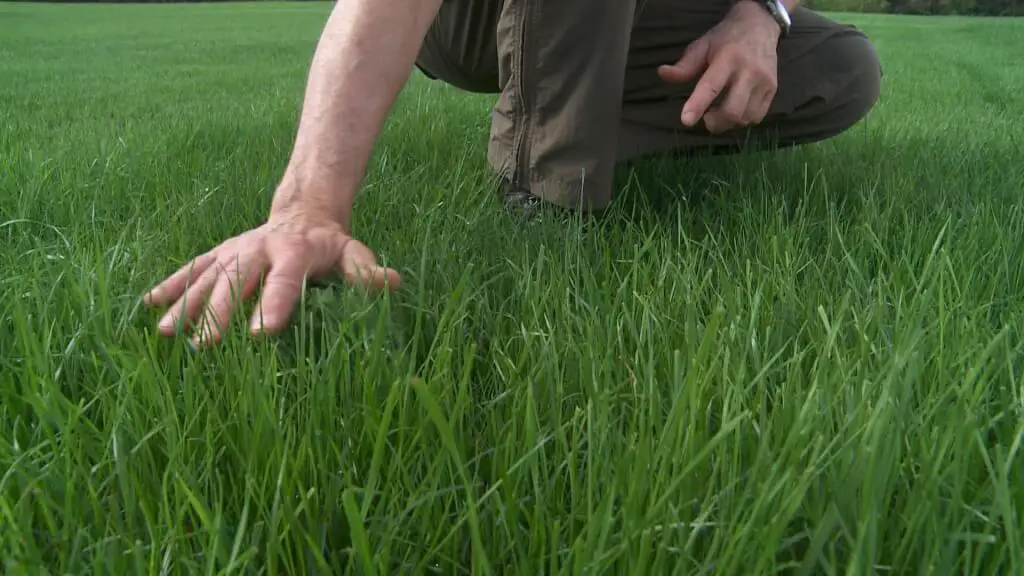Sometimes, people fertilize right at the end of a growing season. But the best time to fertilize your lawn is immediately after undertaking aeration when the soil and roots are open to let the nutrients in. You also want to water your lawn immediately after you fertilize.
Some people prefer fertilizing in the fall a few weeks before winter or in very late spring or early summer, but this isn't advisable. Aerating then makes good sense.
Fertilizing too early can lead to “burning” an in-ground lawn (especially if you still have old grass), making it very brown for months. It could also aggravate problems with diseases because of salt build-up and cause yellow patches in cool-season lawns.
Soil Aeration and Your Lawn's Health
If your lawn becomes too compact, aerate it to alleviate the problem. Use the top two inches of soil so the grass can breathe and feed much better.
If you love dogs, you'll probably want your dog to do his business in that area – which means helping your soil remain healthy! The kids might want to get outside and play yard tag at that exact location. No chemicals will be necessary for a healthy lawn in such areas.
Good grass growth protects the lawn areas with heavy foot traffic and gives the soil an excellent foundation for fertility. The more fertile it is, the better your lawn remains each year.
4-Step Guide To Fertilizing Your Lawn
4 Reasons Why Fertilize
Research shows that applying an effective lawn fertilizer does four critical things for your lawn: it improves the color and vigor of any type of grass, increases disease resistance, controls weeds, and encourages blooming.
In addition, it's essential to use a fertilizer that will give your new grass the spring boost it needs to get off to a good start.
The Best Time To Fertilize
The best time to fertilize your lawn for optimal results begins when the plants are small, just a few inches tall. Applying fertilizer should take place anytime within 12 hours before the rains start. Also, remember to do this before temperatures become too extreme.
Springtime is the best time when the young plants have only recently started to put up new leaves and have not yet reached maturity. Early spring growth requires more soil nutrients than when the grass is fully mature, such as in late summer growth.
As spring moves into warmer months, gradually increase either nitrogen, phosphorous, or potassium—but distribute no more than one application per month to avoid burning your lawn with excess nutrients.
How Often Should You Fertilize Your Lawn?
The rule of thumb is: Don't over-fertilize lawn! Do not fertilize your lawn more than once a month.
Over-fertilizing your lawn causes fertilizer burn. Fertilizer burn occurs when nitrogen and salt levels increase in the soil, killing the lawn grass. The grass color changes from green to yellow, or green with brown stripes, and even some parts become entirely dead.
To avoid over-fertilization, note the date you applied the lawn food and make a fertilizer application schedule. Most importantly, check the manufacturer's recommendations on the frequency of application.
The Best Types of Fertilizers For Your Lawn
There are two types of fertilizers homeowners can use on their lawn – organic fertilizers and chemical fertilizers. Whichever you choose depends on both the type of lawn you have and how much trouble you're willing to go through with the fertilizer.
While far less common than in the past, you'll still find some instances where it makes sense to apply organic fertilizer. Organic options are slow-release. A slow-release fertilizer has longer-lasting effects on the soil.
However, a chemical fertilizer works out better for most mainstream home lawns because it's cheaper and spells less work for gardeners. Of course, when choosing a commercial chemical fertilizer product, make sure you consider whether or not it offers only quick results (commonly referred to as ‘high-nitrogen' fertilization) or if it also acts as a weed-killer/ growth accelerator as well.
Unless otherwise noted, nearly all chemical lawn fertilizers carry a percentage (%) of Nitrogen (N), Phosphorus (P), and Potassium (K) in them. Also, they may list those three numbers in that order on the fertilizer package.
The percentages themselves are representative of the amount of those nutrients each fertilizer puts back into the soil. To put this into perspective, If your chemical fertilizer bears the mark 20/10/10, the first number denotes nitrogen percentage, the 2nd number is phosphorus, and the 3rd number is potassium. Chemical fertilizers are made up of a mix of N-P-K.
Now that you have this knowledge, making an informed decision when shopping for a lawn fertilizer becomes easier. Your lawn will thrive because of the ingredients in the fertilizer.
While phosphorus makes the deep roots and stems strong, thick, and healthy, nitrogen boosts the formation of chlorophyll to produce healthy growing leaves. In addition, potassium strengthens your grass to resist diseases and thrive in harsh climates.
Therefore, chemical fertilizers make the best option for your lawn fertilizer since they contain a combination of nutrients that your lawn grass needs.
However, note that some fertilizers are specifically for specific grass types, such as Bermuda grass or St Augustine. Be sure to use a spreader to help make the application a breeze!
How To Maintain Your Lawn After Fertilization?
You should maintain your lawn after fertilization. Lawn care involves watering the lawn regularly to prevent nutrient loss. Just be careful not to water too heavily, or the fertilizer will run off your lawn. A sprinkler can make the process easy.
It is also important to mow the lawn at least two times per week, but more frequently in periods of high temperatures and high humidity. If you cannot mow your lawn as often as needed, leave it long until you can mow it again. This will help retain moisture in the soil and protect against excessive heat and sun exposure.
In addition, if your lawn has a lot of grass clippings from your mower, rake them up daily and place them in a compost pile or the garbage. The clippings are organic material, and they should not be allowed to sit on the lawn, or they will begin to decompose and leech their nutrients back into the soil.
After completing this, use a leaf blower on the entire lawn to remove any other foreign matter that could harm your grassy blades.
Again pay close attention to areas of your lawn where animals tread or play. Such high-traffic areas can take an entire season to regain their original strength and density.

